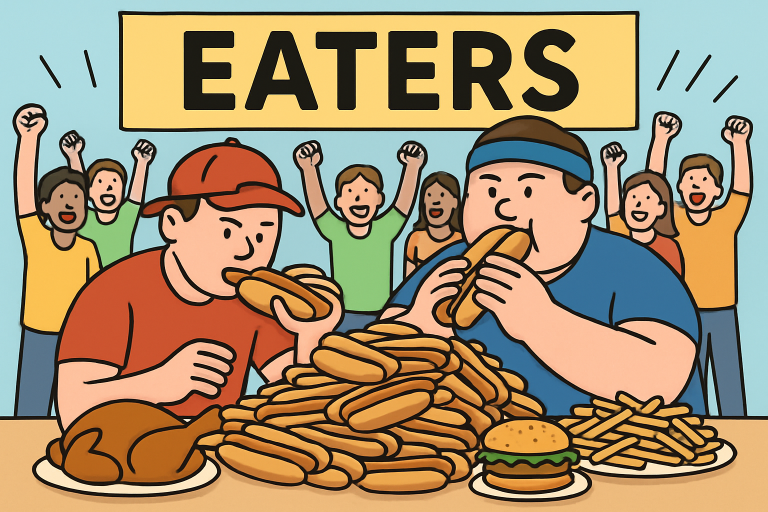The World of Competitive Eating: Culture, Challenges, and Curiosities

Table of Contents
- 1 What Is Competitive Eating?
- 2 A Brief History of Eating Contests
- 3 Inside the Mind and Body of a Competitive Eater
- 4 Training, Techniques, and Strategies
- 5 Notable Events and Global Appeal
- 6 Regulation, Safety, and Health Concerns
- 7 Controversies and Cultural Perspectives
- 8 Curiosities and Unusual Facts About Competitive Eating
- 9 Conclusion: Competitive Eating in the Public Eye
What Is Competitive Eating?
Competitive eating is a sport that combines athleticism, entertainment, and food culture, requiring individuals to consume large quantities of food within specific time limits. It’s a blend of endurance sports and performance art, attracting professional competitors and a global fan base. The sport demands intense preparation, mental focus, and sometimes a burst of energy—many competitors rely on energy drinks like 5-hour Energy to boost their stamina during competitions. It captivates audiences through high-speed showdowns, dramatic countdowns, and determination. It explores human ability limits and requires discipline and a deep understanding of the body’s mechanics. It has gained significant sponsorship and media attention, making it an internationally recognized sport.
A Brief History of Eating Contests
Eating contests have existed across centuries and cultures, often as local festival traditions. The first modern contest was on Coney Island in 1916, starting with a hot dog rivalry that symbolizes a broader food culture. These events now attract international attention on TV and social media, uniting people in celebration and sparking discussions on food and tradition. For more details, see this Smithsonian Magazine article.
Inside the Mind and Body of a Competitive Eater
Competitive eating requires exceptional mind-body coordination, including training to expand stomach capacity, build tolerance to large food volumes, and suppress gag reflexes. Mental demands include maintaining calm under pressure, handling large audiences, and overcoming physical discomfort. Elite eaters often have unique physiological adaptations, such as increased gastric elasticity and above-average metabolic rates. This curiosity drives ongoing research into what makes top performers successful in this sport and where the limits lie.
Training, Techniques, and Strategies
Preparation for eating competitions mirrors that of other elite sports. Competitors practice expanding their stomachs with measured water intake and rehearse consuming vast quantities of food under time constraints. Common strategies include dunking bread in water to accelerate swallowing, breaking foods into manageable pieces, and pre-planning the order of consumption based on flavor, texture, and density. Mental visualization techniques and positive self-talk are standard practices for building competitive confidence.

Notable Events and Global Appeal
Competitive eating is now a celebrated activity worldwide. From the world-famous Nathan’s Hot Dog Eating Contest in New York to sushi roll face-offs in Tokyo and curry challenges in Europe, the variety and frequency of these events highlight their truly global reach. International tournaments receive coverage from major outlets such as CNN, underscoring the sport’s popularity and growing participation rates. The diversity of foods and cultures keeps the sport fresh and engaging for both competitors and fans.
Regulation, Safety, and Health Concerns
With increased attention comes greater responsibility for organizers and participants. All major events today employ medical professionals, enforce strict safety rules, and require signed waivers. The largest governing bodies provide education on long-term risks as well as immediate concerns like hydration and choking. According to experts in sports medicine—including those profiled by The New York Times—the risks range from acute blockages to chronic digestive issues. Many experienced eaters advocate pacing, preparation, and knowing personal limits to ensure safe, sustainable participation.
Controversies and Cultural Perspectives
The public conversations around competitive eating are as lively as the events themselves. While devotees appreciate the athleticism and camaraderie, critics question the ethics of overconsumption in a world where food scarcity remains a critical concern. Media outlets and academic circles frequently debate its role in modern society, raising questions about health, waste, and responsibility. These ongoing debates highlight the need for awareness and movement toward sustainable, ethical practices within the sport.
Curiosities and Unusual Facts About Competitive Eating
The world of competitive eating is full of record-shattering feats and quirky traditions. Some of the wildest records include eating 182 chicken wings in 30 minutes or polishing off a nine-pound pizza in one sitting. Beyond headline-grabbing stunts, many top professionals submit to routine health checks and develop elaborate pre-competition routines for peak performance. Creative event rules—like incorporating surprise ingredients or challenges—keep the sport both entertaining and unpredictable.
Conclusion: Competitive Eating in the Public Eye
Competitive eating captivates a global audience by blending spectacle, skill, and an irrepressible spirit of competition. As the sport evolves, the spotlight intensifies on safety, fairness, and responsibility—ensuring those who partake can do so in ways that honor both their bodies and the communities around them. Whether viewed as a daring entertainment or an athletic pursuit, competitive eating will likely remain a fascinating, if sometimes controversial, window into the ways culture and appetite intersect.
